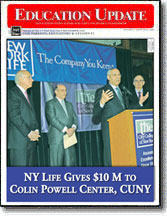|

View
All Articles
Download
PDF |
The Salzburg Festival
Mozart’s best known Operatic Masterpieces
By Irving Spitz
|
Isabel Bayrakdarian (Zerlina), Thomas Hampson (Don Giovanni), extras
(Copyright: Hans Jörg Michel) |
|
Ildebrando D'Arcangelo (Leporello), Thomas Hampson (Don Giovanni), Robert Lloyd (Il Commendatore), extras
(Copyright: Hans Jörg Michel) |
|
Christine Schäfer (Cherubino), Anna Netrebko (Susanna), Uli Kirsch (Cherubim)
(Copyright: Monika Rittershaus) |
For the first and probably last time, the recent Salzburg festival traversed Mozart’s full operatic oeuvre. His legacy as the greatest of all operatic composers rests largely on seven of his 22 operas which include the Marriage of Figaro, Don Giovanni, Cosi fan tutte, the Magic Flute and the Abduction from the Seraglio.
Singing was of the highest order. Only Salzburg could mount night after night singers of such eminence. Highest accolades go to the German soprano Christine Schafer who took the demanding vocal roles of Cherubino in Figaro and Donna Anna in Don Giovanni. Equally impressive was Ildebrando D’Arcangelo who excelled as Leporello in Don Giovanni as well as in the title role in the Marriage of Figaro. Both these consummate artists need to be complimented for performing these demanding roles, which are so distinctive both vocally and emotionally and being equally convincing in both. There were other unforgettable vocal performances such as that of Thomas Hampson, whose superb acting and singing have placed his as the leading Don Giovanni around today. The dazzling Russian soprano, Anna Netrebko showed her mettle as a discreet Susanna in the Marriage of Figaro as did Dorothea Roschmann as the desperate Countess. Never have I heard the Countess’s poignant arias, Porgi Amor (God of love) and Dove Sono (I remember days long departed), sound so convincing. Rene Pape as Sarastro and Diana Damrau as the Queen of the Night set standards in the Magic Flute which will be difficult to surpass. The Vienna Philharmonic, in the pit almost every night of the festival, lent wonderful support in Figaro, Don Giovanni, Cosi and the Magic Flute under the batons of conductors, Nicolaus Harnoncourt, Daniel Harding Manfred Honeck and Riccardo Muti.
Several of the operas received ultramodern productions, somewhat of a contradiction for a festival generally recognized as being a bastion of tradition. Christian Schmidt set Figaro on multiple levels on cold empty stairways in the home of Count Almaviva. This opera is a comedy par excellence. However director Claus Guth choose to ignore this aspect as well as the political and social implications of the opera. Under Guth, the marital crisis in the Almaviva household was much in evidence. The atmosphere was cold, traumatic and violent. These were angry people particularly at the conclusion of Act 1 where the jealous Figaro turns angrily on Cherubino, jabs at his arm with scissors smearing blood on his face, all this while singing the incomparable show-stopper, non piu andrai (say goodbye now to pastime). Guth added a non-speaking male with wings, presumably the god Amor, who hovered over the proceedings, coaxing and cajoling the protagonists. Harnoncourt’s interpretation was slow, authoritative and unquestionably magisterial.
Under director Martin Kusej and stage designer Martin Zehetgruber, Don Giovanni opened with a large photo splashed across the stage featuring six scantily clad girls lying provocatively on their stomachs. Girls in trench coats then marched across the stage. These were soon shed for white underwear in which they remained for most of the performance, changing to black lingerie in the final act where the Don meets with his nemesis the Commendatore. The revolving stage was simple revealing plain sterile interiors.
The most controversial production was The Abduction of the Serail. This opera has a simple comic innocent plot. Konstanza and her servant Blonde are abducted by the Turkish Pasha. Konstanza’s lover, Belmonte, and his servant, Pedrillo, try to rescue the ladies. They are caught but are pardoned in a magnanimous gesture by the Pasha. Director Stefan Herheim and dramaturg Wolfgang Willaschek would have none of this playful innocence. Instead of depicting two ardent pairs of lovers, in this new version, Konstanza was wooed not only by Belmonte and the Pasha, but in addition by Pedrillo and Osmin, the servant of the Pasha. There was also violence and rape. To justify their case, the directing team took license to change the spoken dialog. There is no harm in transplanting an opera into another time and place. However a production should reflect the original text. This was certainly not the case with this Abduction. This said, it should be stated that there was some remarkable singing, notably that of Konstanza by Laura Aikin. Franz Hawlata as Osmin was also very convincing.
All in all, this feast of Mozart was a unique experience and the Salzburg Festival needs to be congratulated for this noble enterprise in staging all of Mozart’s operas, an endeavor which is unlikely to be repeated again.
|
|
